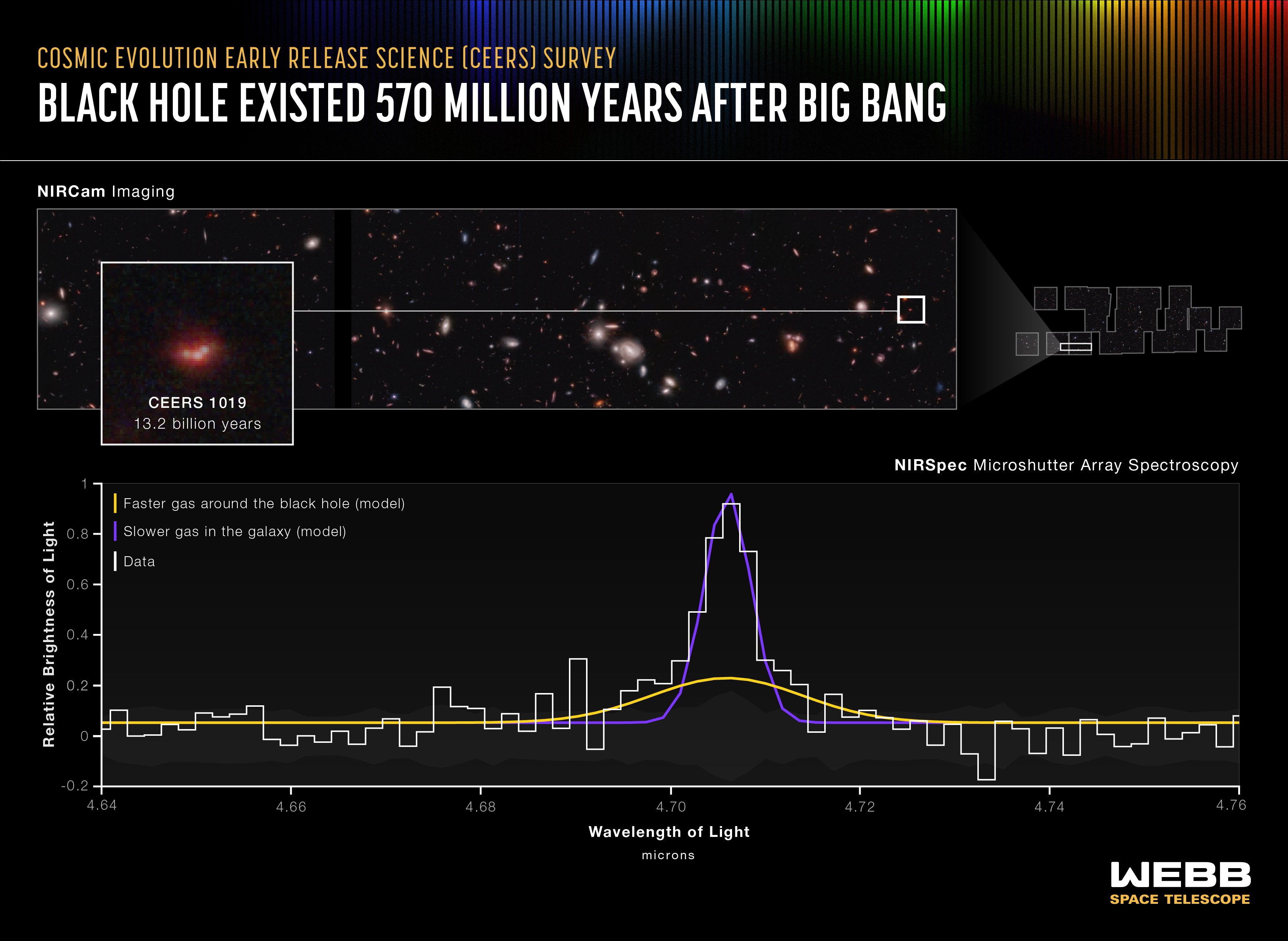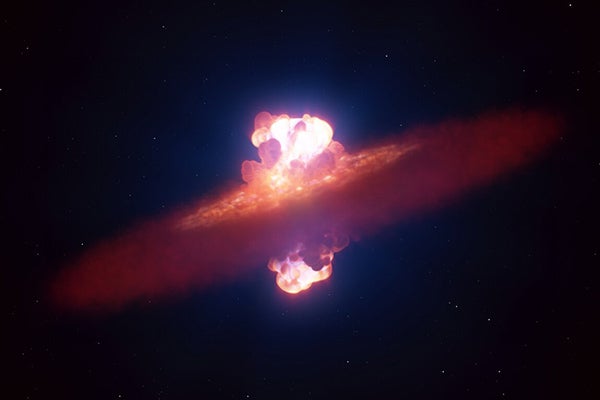Webb Telescope Detects Most Distant Active Supermassive Black Hole
At about 9 solar masses, this black hole is a real lightweight compared to previously seen ones in the early universe that are typically 1 billion solar masses.

A zoomed-in view of images captured by the James Webb Space Telescope in near-infrared light for the Cosmic Evolution Early Release Science (CEERS) Survey. Image credit: NASA, ESA, CSA, Steve Finkelstein (UT Austin), Micaela Bagley (UT Austin), Rebecca Larson (UT Austin).
Researchers have discovered the most distant active supermassive black hole to date with the James Webb Space Telescope (JWST). The galaxy, CEERS 1019, existed about 570 million years after the big bang, and its black hole is less massive than any other yet identified in the early universe.
In addition to the black hole in CEERS 1019, the researchers identified two more black holes that are on the smaller side and existed 1 billion and 1.1 billion years after the big bang. JWST also identified eleven galaxies that existed when the universe was 470 million to 675 million years old. The evidence was provided by JWST’s Cosmic Evolution Early Release Science (CEERS) Survey, led by Steven Finkelstein, a professor of astronomy at The University of Texas at Austin. The program combines JWST’s highly detailed near- and mid-infrared images and data known as spectra, all of which were used to make these discoveries.
“Looking at this distant object with this telescope is a lot like looking at data from black holes that exist in galaxies near our own,” said Rebecca Larson, a recent Ph.D. graduate at UT Austin, who led the study. “There are so many spectral lines to analyze!”
The team has published these results in several initial papers in a special edition of The Astrophysical Journal Letters.
CEERS 1019 is notable not only for how long ago it existed, but also for the surprising size of its black hole. It clocks in around 9 million solar masses, far less than other black holes that also existed in the early universe and were detected by other telescopes, but larger than expected for so early in cosmic history. Those behemoths typically contain more than 1 billion times the mass of the sun – and they are easier to detect because they are much brighter. The black hole within CEERS 1019 is more like the black hole at the center of our Milky Way galaxy, which is 4.6 million times the mass of the sun.
Though smaller, this black hole existed so much earlier that it is still difficult to explain how it formed so soon after the universe began. Researchers have long known that smaller black holes must have existed earlier in the universe, but it wasn’t until JWST began observing that they were able to make definitive detections.

A team of researchers led by Steven Finkelstein and Rebecca Larson from The University of Texas at Austin have identified the most distant active supermassive black hole to date in the James Webb Space Telescope’s Cosmic Evolution Early Release Science (CEERS) Survey. The black hole, within galaxy CEERS 1019, existed just over 570 million years after the big bang and is far less massive than other black holes previously found in the early universe. Illustration credit: NASA, ESA, CSA, Leah Hustak (STScI).
Not only could the team untangle which emissions in the spectrum are from the black hole and which are from its host galaxy, they could also pinpoint how much gas the black hole is ingesting and determine its galaxy’s star-formation rate.
The team found this galaxy is ingesting as much gas as it can while also churning out new stars. They turned to the images to explore why that might be. Visually, CEERS 1019 appears as three bright clumps, not a single circular disk.
“We’re not used to seeing so much structure in images at these distances,” said CEERS team member Jeyhan Kartaltepe, an associate professor of astronomy at the Rochester Institute of Technology in New York. “A galaxy merger could be partly responsible for fueling the activity in this galaxy’s black hole, and that could also lead to increased star formation.”
These are only some of the first groundbreaking findings from the CEERS Survey.
“Until now, research about objects in the early universe was largely theoretical,” Finkelstein said. “With Webb, not only can we see black holes and galaxies at extreme distances, we can now start to accurately measure them. That’s the tremendous power of this telescope.”
In the future, it’s possible JWST’s data may also be used to explain how early black holes formed, revising researchers’ models of how black holes grew and evolved in the first several hundred million years of the universe’s history.
The James Webb Space Telescope is an international program led by NASA with its partners, the European Space Agency and the Canadian Space Agency.
Full-resolution images are available here: https://webbtelescope.org/contents/news-releases/2023/news-2023-114#section-id-2

This graphic shows detections of the most distant active supermassive black holes currently known in the universe. Three, including the most distant (within the galaxy CEERS 1019), were recently identified by the James Webb Space Telescope’s Cosmic Evolution Early Release Science (CEERS) Survey. The new CEERS black holes are much smaller than any others detected before in the early universe. Illustration credit: NASA, ESA, CSA, Leah Hustak (STScI).
More Extremely Distant Black Holes and Galaxies
The CEERS Survey is expansive, and there is much more to explore. Team member Dale Kocevski of Colby College in Waterville, Maine, and the team quickly spotted another pair of small black holes in the data. The first, within galaxy CEERS 2782, was easiest to pick out. There isn’t any dust obscuring JWST’s view of it, so researchers could immediately determine when its black hole existed in the history of the universe – only 1.1 billion years after the big bang. The second black hole, in galaxy CEERS 746, existed slightly earlier, 1 billion years after the big bang. Its bright accretion disk, a ring made up of gas and dust that encircles its supermassive black hole, is still partially clouded by dust.
“The central black hole is visible, but the presence of dust suggests it might lie within a galaxy that is also furiously pumping out stars,” Kocevski explained.
Like the one in CEERS 1019, the two other newly described black holes (in galaxies CEERS 2782 and CEERS 746) are also “light weights” – at least when compared with previously known supermassive black holes at these distances. They are only about 10 million times the mass of the sun.
“Researchers have long known that there must be lower mass black holes in the early universe. Webb is the first observatory that can capture them so clearly,” Kocevski said. “Now we think that lower mass black holes might be all over the place, waiting to be discovered.”
Before JWST, all three black holes were too faint to be detected.
“With other telescopes, these targets look like ordinary star-forming galaxies, not active supermassive black holes,” Finkelstein added.
JWST’s sensitive spectra also allowed these researchers to measure precise distances to, and therefore the ages of, galaxies in the early universe. Team members Pablo Arrabal Haro of the National Science Foundation’s NOIRLab and Seiji Fujimoto, a postdoctoral researcher and Hubble fellow at UT Austin, identified 11 galaxies that existed 470 million to 675 million years after the big bang. Not only are they extremely distant, the fact that so many bright galaxies were detected is notable. Researchers theorized that JWST would detect fewer galaxies than are being found at these distances.
“I am overwhelmed by the amount of highly detailed spectra of remote galaxies Webb returned,” Arrabal Haro said. “These data are absolutely incredible.”
These galaxies are rapidly forming stars but are not yet as chemically enriched as galaxies that are much closer to home.
“Webb was the first to detect some of these galaxies,” explained Fujimoto. “This set, along with other distant galaxies we may identify in the future, might change our understanding of star formation and galaxy evolution throughout cosmic history,” he added.
The team published several initial papers about CEERS Survey data in a special edition of The Astrophysical Journal Letters: “A CEERS Discovery of an Accreting Supermassive Black Hole 570 Myr after the Big Bang: Identifying a Progenitor of Massive z > 6 Quasars,” led by Larson, “Hidden Little Monsters: Spectroscopic Identification of Low-Mass, Broad-Line AGN at z > 5 with CEERS,” led by Kocevski, “Spectroscopic confirmation of CEERS NIRCam-selected galaxies at z≃8−10,” led by Arrabal Haro, and “CEERS Spectroscopic Confirmation of NIRCam-Selected z ≳ 8 Galaxy Candidates with JWST/NIRSpec: Initial Characterization of their Properties,” led by Fujimoto.
This was adapted from a news release by the Space Telescope Science Institute.



